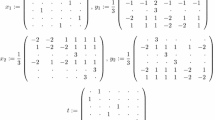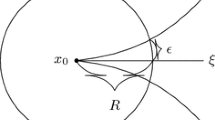Abstract
This short chapter is a supplement recalling some basic facts on non-crystallographic finite Coxeter groups and raising questions concerning a possible tetrahedron-type equation.
Access provided by Autonomous University of Puebla. Download chapter PDF
Similar content being viewed by others
9.1 Finite Coxeter Groups
The list of finite Coxeter groupsFootnote 1 is given by [59]:
The indices are called ranks. The alphabetically last one \(I_2(m)\) is the dihedral group which is the order 2m group of symmetry of a regular m-gon consisting of orthogonal transformations. It has overlap with the other rank 2 members for \(m =3,4,6\). See Fig. 9.2. Rank n Coxeter groups have a presentation in terms of generators \(s_1,\ldots , s_n\) obeying the relations \((s_is_j)^{m_{ij}}=1\) with \(m_{ii}=1\) and \(m_{ij}=m_{ji} \in \{2,3,\ldots \}\cup \{\infty \}\) for \(i \ne j\), where \(m_{ij}=\infty \) is to be understood as no relation. The data \(\{m_{ij}\}\) is customarily encoded in the Coxeter graph. Its vertex set is \(\{1,2,\ldots , n\}\), and the two vertices i and j are connected by an unlabeled edge if \(m_{ij}=3\) and by an edge labeled with \(m_{ij}\) if \(4 \le m_{ij}< \infty \). The case \(\forall m_{ij} \in \{2,3,4,6\}\) is called crystallographic, and has a realization as the Weyl group of the corresponding Lie algebras. Thus those on the second line in (9.1), except \(m=3,4,6\), are the non-crystallographic finite Coxeter groups (Fig. 9.1).
Coxeter graphs of (9.1). Unlike the Dynkin diagrams, there is no arrow and \(C_n\) has been merged into \(B_n\)
The dihedral groups \(I_2(m)\) and \(H_2, H_3, H_4\) admit various embeddings as shown in Fig. 9.2.
The embedding of type \(X_n\hookrightarrow X_{n+1}\) just means that \(X_n\) is a parabolic subgroup of \(X_{n+1}\). Denoting the generators in the image by \(t_i\)’s, the other cases are given as follows [134]:
The embedding \(B_2 \hookrightarrow A_3\) is a folding by the order 2 diagram automorphism, and has the generalization to \(B_n \hookrightarrow A_{2n-1}\ (n \ge 2)\) as \(s_i \mapsto t_it_{2n-i}\,(1\le i<n)\) and \(s_n \mapsto t_n\).
9.2 Tetrahedron-Type Equation for the Coxeter Group \(H_3\)
For any element w of a Coxeter group, one can consider a reduced expression (rex) graph. The vertices are reduced expressions of w and the two are connected by an edge if and only if they are transformed by a single application of the Coxeter relation \((s_is_j)^{m_{ij}}=1\, (i \ne j)\). According to [126, Theorem 2.17], any non-trivial loop in a rex graph is generated from the loops in the rex graph of the longest element in the parabolic subgroups of rank 3. See also [44, Sect. 1.4.3]. In this sense, rank 3 cases are essential. In fact, we have seen that the \(A_3\) and \(B_3\) cases led to the tetrahedron and the 3D reflection equationsFootnote 2 in earlier chapters, respectively. The remaining case is \(H_3\), which we shall consider in what follows.
The Coxeter group \(H_3\) is known as the symmetry of the icosahedron or equivalently the dual dodecahedron [59]. The relations of the generators \(s_1, s_2, s_3\) read as \(s_1^2=s_2^2=s_3^2=1\) and
Unlike the case of crystallographic Coxeter groups, the approach by a quantized coordinate ring is not available. However, one can formulate a compatibility equation formally by an argument similar to those for the crystallographic cases. We attach operators to the transformations in (9.6), denoted by only indices, as follows:
where, as before, the lower indices \(i,j,k,\ldots \) of the operators specify the components that they act on non-trivially. The operators \(\Omega \) and Y are the characteristic ones which are expected to come from \(H_2\).
A reduced expression of the longest element of \(H_3\) is
which has the length 15. Now the process analogous to (3.93), (5.106) and (7.16) reads as
It reverses the initial reduced word. There is another route achieving the reverse ordering which is related to (9.11), similarly to (7.17) and (7.18). Equating the two ways, substituting (9.7), (9.9) and assuming that \(P_{i,j}\) just exchanges the indices as \(P_{4,7}Y_{1,3,4,9} = Y_{1,3,7,9}P_{4,7}\) etc., we get the \(H_3\) analogue of the tetrahedron equation:
There are 6 \(Y^{\pm 1}\)’s and 10 \(R^{\pm 1}\)’s on each side. If \(Y^{-1}_{ijklm}=Y_{ijklm}=Y_{mlkji}\) and \(R^{-1}_{ijk}=R_{ijk}=R_{kji}\) are valid, the above equation reduces to
A diagrammatic representation of the reduced version (9.13) of the \(H_3\) compatibility equation is available in [44, Eq. (4.9)].
9.3 Discussion on the Quintic Coxeter Relation
The operator Y has been introduced formally in (9.9) in association with the quintic Coxeter relation. It is natural to seek it in the parabolic subgroup \(H_2 \subset H_3\). In this section, we study a composition of the birational 3D R (Sect. 3.6.2) corresponding to the transformation of \(s_1s_2s_1s_2s_1\) into \(s_2s_1s_2s_1s_2\) in \(H_2\) under the embedding \(H_2 \hookrightarrow A_4\).
The embedding is the \(m=5\) case of (9.2), which reads as \(s_1 \mapsto t_1 t_3\), \(s_2 \mapsto t_2t_4\). One way to realize \(s_1s_2s_1s_2s_1 = s_2s_1s_2s_1s_2\) in the image is the following transformation of the reduced expression of the longest element of \(A_4\):
As before, we have assigned an operator to each step, where \(P_{ij}\) is the transposition and \(\Phi _{ijk}=R_{ijk}P_{ik}\) with \(R_{ijk}=R^\lambda _{ijk}\) being the \(\lambda \)-deformed biraitonal 3D R (3.159).Footnote 3 The composition of the operators in (9.14) is rearranged as \(\tilde{Y} \sigma \), where \(\sigma \) is a product of \(P_{ij}\)’s giving the reverse ordering permutation in \(\mathfrak {S}_{10}\), and \(\tilde{Y}\) has the form
This is a totally positive involutive rational map of 10 variables \((x_1,\ldots , x_{10})\). Set \((x'_1,\ldots , x'_{10}) = {\tilde{Y}}((x_1,\ldots , x_{10}))\). Then examples of simplest components are
One can directly check:
Proposition 9.1
The map \(\tilde{Y}\) preserves the following:
One can get totally positive involutive maps of 5 variables by restricting the 6-dimensional space (9.19) by a conserved quantity. For instance, imposing \(a=x_2x_4x_5x_7\) in the space (9.19) leads to the map \((x_1,x_2,x_3,x_4,x_6) \mapsto (x''_1,x''_2,x''_3,x''_4,x''_6) \) defined by
depending on the parameter a. However, there is no canonical way of doing such a reduction, and construction of a solution to the \(H_3\) compatibility equation (9.12) or (9.13) remains as a challenge.
These features, especially the discrepancy of (9.19) from the desired dimension 5, stem from the fact that \(H_2\) viewed as a subgroup \(A_4\) is not an invariant of the diagram automorphism. In contrast, for the embedding \(B_2 \hookrightarrow A_3\) respecting the diagram automorphism, the composition of the birational 3D R’s corresponding to the length 6 longest element of \(A_3\) admits a natural restriction to the 4-dimensional subspace matching the 3D K [152] and reproduces [110, Remark 5.1]. Another example of such an embedding is \(G_2 \hookrightarrow D_4\), which allows one to construct a \(\lambda \)-deformation of the birational 3D F (8.74).Footnote 4
Notes
- 1.
In this chapter, symbols like \(A_n\) are used to mean Coxeter groups instead of Lie algebras, unlike elsewhere in the book.
- 2.
We have actually encountered a fine difference between \(B_3\) and \(C_3\) versions originating in the relevant quantized coordinate rings.
- 3.
\(\Phi ^{-1}=\Phi \) has been taken into account due to \(P^{-1}=P, R^{-1}=R, R_{ijk}=R_{kji}\).
- 4.
Private communication with the author of [152].
Author information
Authors and Affiliations
Corresponding author
Rights and permissions
Copyright information
© 2022 The Author(s), under exclusive license to Springer Nature Singapore Pte Ltd.
About this chapter
Cite this chapter
Kuniba, A. (2022). Comments on Tetrahedron-Type Equation for Non-crystallographic Coxeter Groups. In: Quantum Groups in Three-Dimensional Integrability. Theoretical and Mathematical Physics. Springer, Singapore. https://doi.org/10.1007/978-981-19-3262-5_9
Download citation
DOI: https://doi.org/10.1007/978-981-19-3262-5_9
Published:
Publisher Name: Springer, Singapore
Print ISBN: 978-981-19-3261-8
Online ISBN: 978-981-19-3262-5
eBook Packages: Physics and AstronomyPhysics and Astronomy (R0)






